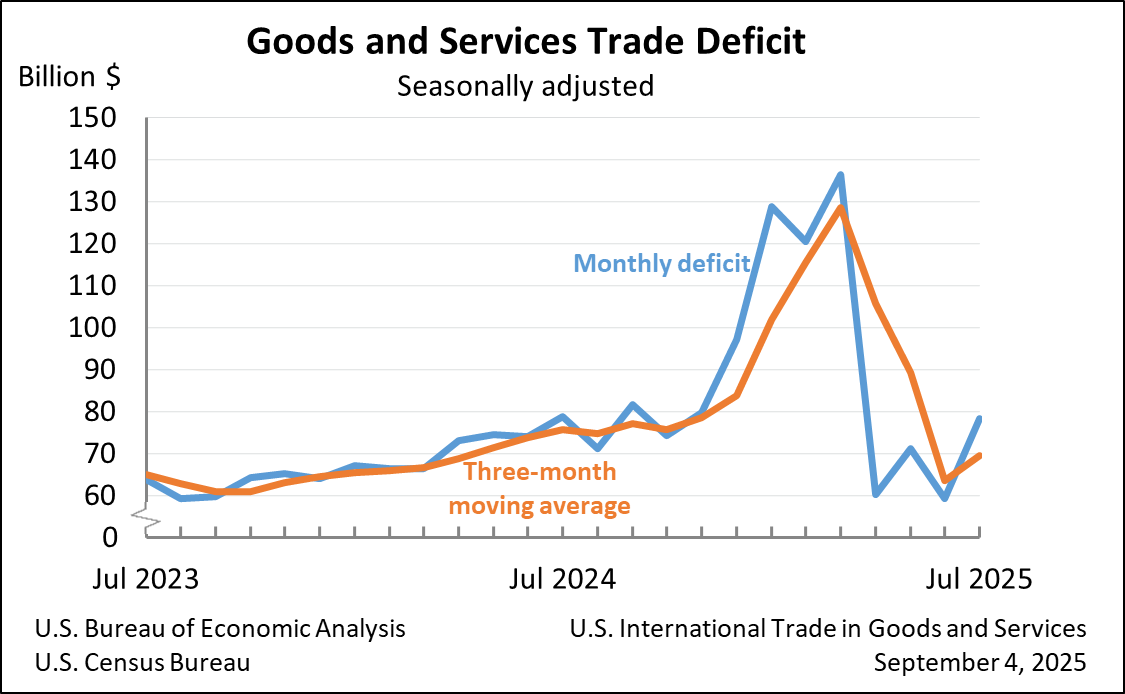Bureau of Economic Analysis
U.S. International Trade in Goods and Services, July 2025
The U.S. goods and services trade deficit increased in July 2025 according to the U.S. Bureau of Economic Analysis and the U.S. Census Bureau. The deficit increased from $59.1 billion in June (revised) to $78.3 billion in July, as imports increased more than exports. The goods deficit increased $18.2 billion in July to $103.9 billion. The services surplus decreased $1.1 billion in July to $25.6 billion.
Principal Federal Economic Indicators
Noteworthy
The Latest
Local Area Personal Income: Metropolitan Areas, 2001–2012
Personal income growth slowed in 2012 in most of the nation’s 381 metropolitan statistical areas (MSAs). Personal income growth slowed in 311 MSAs, accelerated in 65 MSAs, and remained unchanged in 5 MSAs. On average, MSA personal income rose 4.2 percent in 2012, after growing 6.0 percent in 2011. Personal income growth ranged from 12.1 percent in Midland, TX, to –1.6 percent in Yuma, AZ, one of only five MSAs where personal income declined…
Local Area Personal Income, 2001-2012 (benchmark estimate)
Personal income growth slowed in 2012 in most of the nations 381 metropolitan statistical areas (MSAs), according to estimates released today by the U.S. Bureau of Economic Analysis. Personal income growth slowed in 311 MSAs, accelerated in 65 MSAs, and remained unchanged in 5 MSAs. On average, MSA personal income rose 4.2 percent in 2012, after growing 6.0 percent in 2011. Personal income growth ranged from 12.1 percent in Midland, Texas to…
September 2013 Trade Gap is $41.8 Billion
The U.S. monthly international trade deficit increased in September 2013 according to the U.S. Bureau of Economic Analysis and the U.S. Census Bureau. The deficit increased from $38.7 billion in August (revised) to $41.8 billion in September as exports decreased and imports increased. The previously published August deficit was $38.8 billion. The goods deficit increased $3.0 billion from August to $61.3 billion in September; the services…
Personal Income Increases in September
Personal income rose 0.5 percent in September, the same as in August. Wages and salaries, the largest component of personal income, rose 0.4 percent after rising 0.5 percent. Farm proprietors’ income was boosted in September, reflecting the settlement of a class-action discrimination lawsuit against the U. S. Department of Agriculture.
Current-dollar disposable personal income (DPI), after-tax income, rose 0.5…
Personal Income and Outlays, September 2013
Personal income increased $67.4 billion, or 0.5 percent, and disposable personal income (DPI) increased $64.8 billion, or 0.5 percent, in September, according to the Bureau of Economic Analysis. Personal consumption expenditures (PCE) increased $24.7 billion, or 0.2 percent.
GDP Growth Picks Up in Third Quarter
Real gross domestic product (GDP) increased 2.8 percent in the third quarter of 2013, according to the “advance” estimate released by the Bureau of Economic Analysis. In the second quarter, the growth rate was 2.5 percent.
GDP growth The third-quarter growth reflected the following:
Gross Domestic Product, 3rd quarter 2013 (advance estimate)
Real gross domestic product -- the output of goods and services produced by labor and property located in the United States -- increased at an annual rate of 2.8 percent in the third quarter of 2013 (that is, from the second quarter to the third quarter), according to the "advance" estimate released by the Bureau of Economic Analysis.
State Personal Income: Second Quarter 2013
State personal incomes grew 1.0 percent on average in the second quarter of 2013 after falling 1.3 percent in the first quarter. Personal income growth ranged from 1.5 percent in Florida and Arizona to –0.7 percent in Nebraska. The national price index for personal consumption expenditures was unchanged in the second quarter after rising 0.3 percent in the first quarter.
For more information on state personal income, see the…




